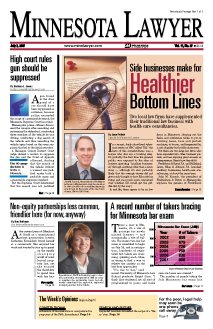The survey also found that 100 percent of participants report having a diversity committee in their firm, up from 96 percent in the prior year. (The survey canvassed large U.S. law firms in the AmLaw 200 and includes responses from 80 participating firms collected in March and April 2008.)

Here in Minnesota, many law firms are following suit. A lot of the larger firms have already implemented diversity committees, and at least one, Robins Kaplan Miller & Ciresi, has hired a diversity manager. E. Marie Broussard (at right) joined the firm earlier this year. She spoke with Minnesota Lawyer about the importance of her position in February.
“The most important thing a diversity manager does is call on the conscience of the people in the organization,” she said. “The law is especially resistant to change. My job is to make sure change happens within the people within the organization.”
The importance of developing and promoting diversity within law firms and the legal community in general can’t be overstated, particularly in Minnesota where we have some difficulty attracting and retaining diverse lawyers. The formation of diversity committees and the hiring of diversity managers are clearly positive steps towards those goals.

 Joanne Colan over at
Joanne Colan over at 
